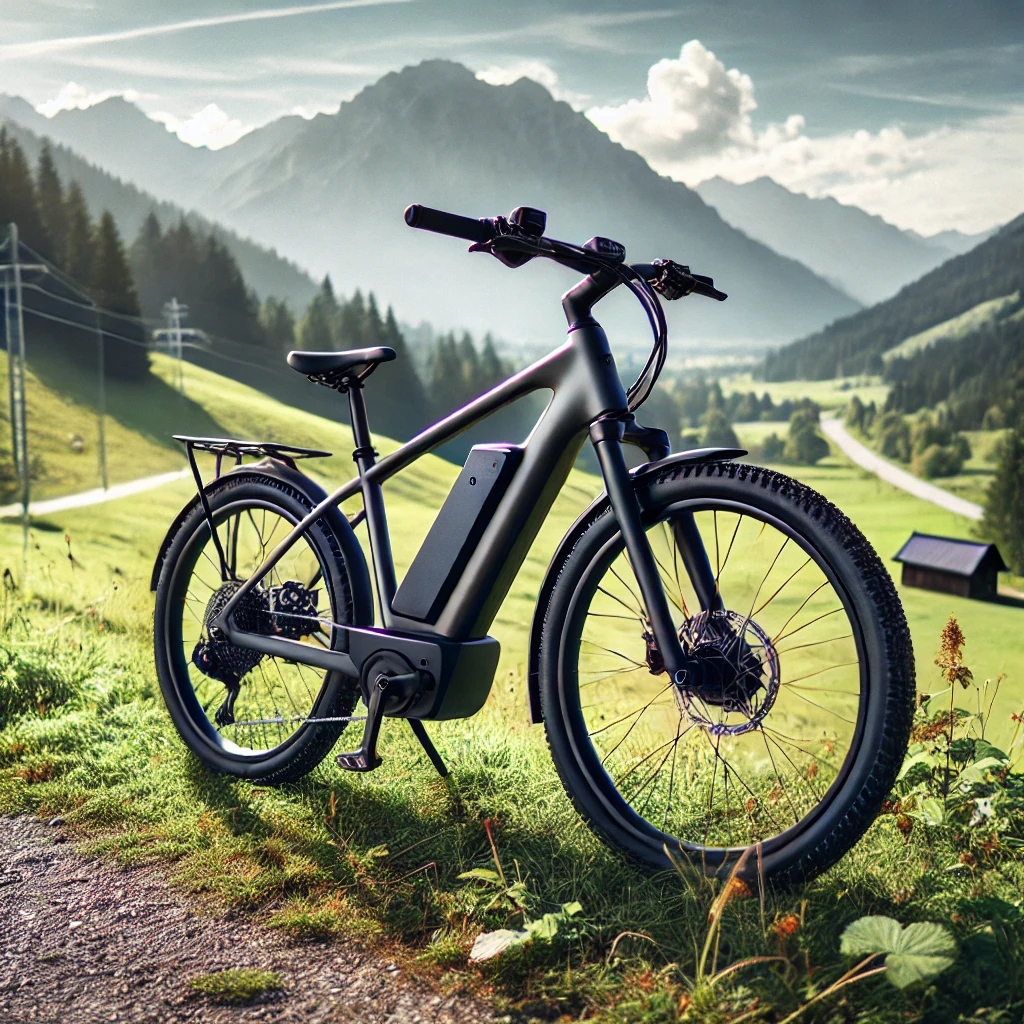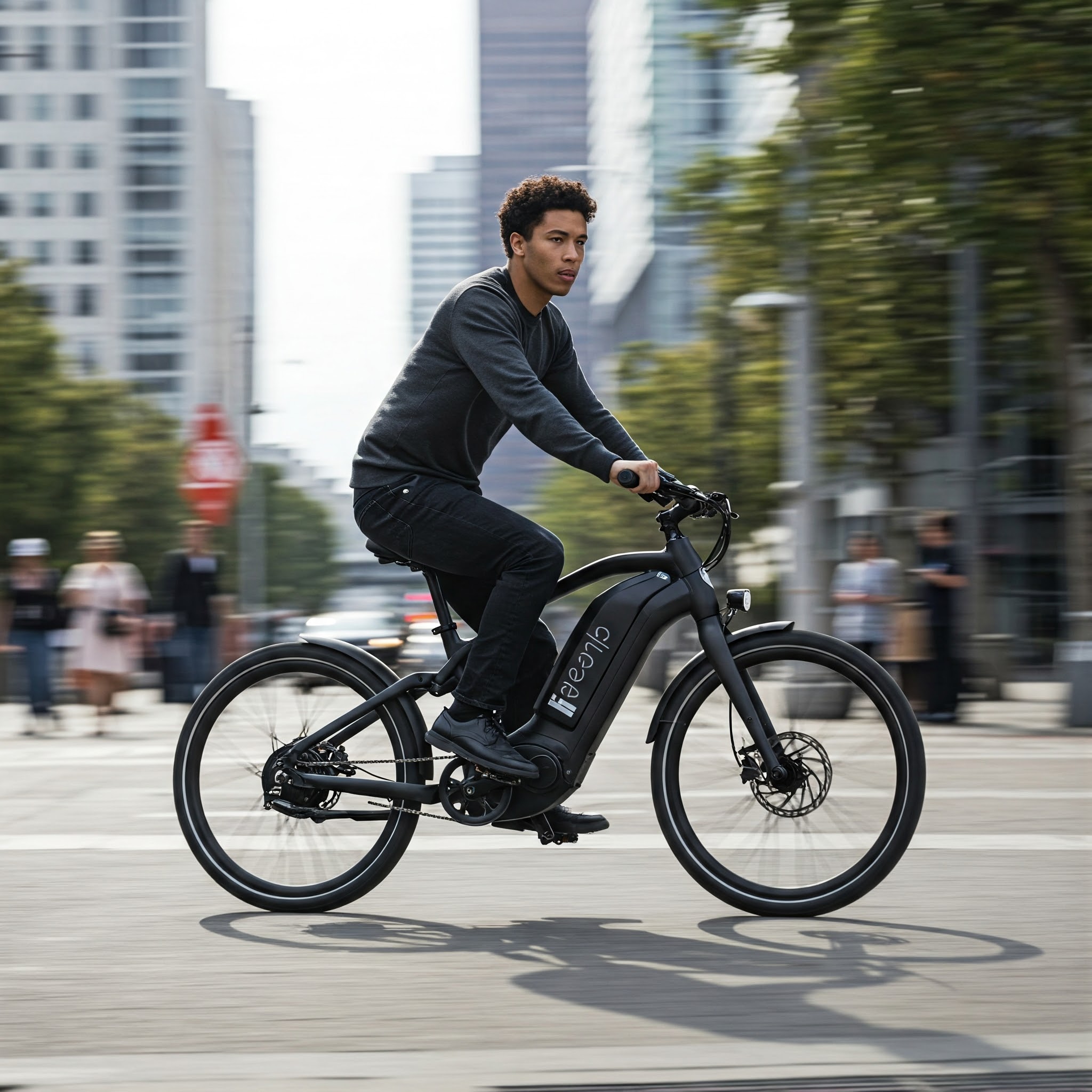Navigating California’s Diverse Terrain
California, with its stunning coastlines, challenging mountain trails, and bustling urban centers, presents cyclists with an incredible variety of riding experiences. As I’ve explored the Golden State on two wheels over the years, I’ve witnessed firsthand the growing debate of ebike vs bike California riders engage in when deciding their preferred mode of transportation. This comprehensive comparison will help you understand the nuances of both options within California’s unique regulatory and geographical context.
✨Was this helpful? Spread the word! 🚀
Recent data from the California Bicycle Coalition shows a remarkable 43% increase in cycling throughout the state since 2020, with ebikes accounting for nearly 30% of new bike sales in urban centers like San Francisco and Los Angeles. This trend reflects both the enduring appeal of traditional bicycles and the rising popularity of electric alternatives in a state known for its progressive stance on sustainable transportation.
Whether you’re commuting through San Diego’s sunny streets, tackling the steep hills of San Francisco, or planning a scenic ride along the Pacific Coast Highway, understanding the ebike vs bike California landscape is essential for making an informed choice that matches your needs, budget, and riding ambitions.

Understanding California’s Unique Cycling Environment
Before diving into the specifics of ebike vs bike California options, it’s important to appreciate the unique conditions that make the Golden State both a cycling paradise and a challenging environment.
Climate Considerations
California’s diverse climate zones create varied cycling conditions throughout the state:
✅ Coastal regions offer mild, year-round riding weather with cool ocean breezes
✅ Inland valleys experience hot summers where temperatures regularly exceed 100°F
✅ Northern California sees more rainfall, particularly during winter months
✅ Mountain regions experience significant seasonal changes, including snow at higher elevations
According to research from the University of California, Davis Institute of Transportation Studies, these climate variations significantly impact cycling patterns and equipment choices throughout the state. For instance, ebike usage tends to spike in hilly areas and during hotter months, while traditional bikes remain dominant in temperate coastal communities with flat terrain.
Geographical Diversity
The state’s varied topography creates distinct challenges for cyclists:
✅ San Francisco’s notorious hills with gradients exceeding 30% in some areas
✅ Long, flat stretches in the Central Valley
✅ Winding mountain roads in the Sierra Nevada range
✅ Densely populated urban centers with varying levels of cycling infrastructure
A 2023 survey by the California Department of Transportation found that terrain considerations rank among the top three factors influencing the ebike vs bike California decision for new cyclists, with 62% of respondents in hilly regions preferring electric assistance.
Ebike vs Bike California: Legal and Regulatory Framework
California has established one of the nation’s most comprehensive regulatory frameworks for ebikes, which directly impacts the ebike vs bike California comparison.
California’s Three-Class Ebike System
The state categorizes electric bicycles into three distinct classes:
✅ Class 1: Pedal-assist only (no throttle), maximum assisted speed of 20 mph
✅ Class 2: Throttle-assisted, maximum speed of 20 mph
✅ Class 3: Pedal-assist only (no throttle), maximum assisted speed of 28 mph
According to the California Vehicle Code Section 312.5, these classifications determine where each type of ebike can legally operate. While traditional bikes face fewer restrictions, understanding these regulations is crucial before investing in an electric option.
Access Restrictions and Permissions
The California State Parks system and local municipalities have established varying levels of access:
✅ Traditional bikes are permitted on virtually all roads, bike lanes, and designated trails
✅ Class 1 and 2 ebikes are allowed on most bike paths and protected lanes
✅ Class 3 ebikes are restricted from certain bike paths and many off-road trails
❌ Some wilderness areas and nature preserves prohibit all forms of electric assistance
As noted in a recent California Bicycle Coalition report, these regulations continue to evolve as ebike usage increases, with some counties and cities implementing their own specific ordinances that may differ from state guidelines.
Performance Comparison: Ebike vs Bike California
When evaluating ebike vs bike California performance, several key factors come into play that are particularly relevant to the state’s unique conditions.
Speed and Efficiency
Comparing real-world performance across different California environments:
✅ Traditional bikes:
- Average speeds of 10-14 mph for recreational riders on flat terrain
- Highly efficient on descents and well-maintained surfaces
- Require significant effort on hills and against prevailing coastal winds
✅ Ebikes:
- Consistent speeds of 15-20 mph regardless of terrain (Class 1 and 2)
- Can maintain speeds up to 28 mph with pedal assistance (Class 3)
- Provide crucial support against headwinds common along coastal routes
Research conducted at Stanford University’s Transportation Research Center indicates that the average ebike commuter in California arrives at their destination 23% faster than traditional cyclists when traveling the same routes, with significantly lower perceived exertion.
Range and Endurance
Understanding distance capabilities within California’s diverse landscapes:
✅ Traditional bikes:
- Unlimited range dependent only on rider fitness
- Ideal for established routes with known terrain
- More vulnerable to unexpected challenging conditions
✅ Ebikes:
- Typical range of 20-80 miles depending on battery capacity, terrain, and assistance level
- Require charging infrastructure for longer journeys
- Battery performance can be affected by extreme heat in desert regions
A 2024 survey of California ebike owners revealed that the average rider achieves 45 miles per charge in mixed conditions, with range anxiety becoming a concern primarily for recreational riders attempting longer scenic routes rather than daily commuters.
Rad Power Bikes RadCity 5 Plus – Perfect for California Urban Commuting
When discussing ebike vs bike California options for city riding, the Rad Power Bikes RadCity 5 Plus stands out as an exceptional choice for navigating urban environments. This purpose-built commuter ebike features a 750W motor that handles San Francisco hills with ease while maintaining a range of up to 50 miles per charge – perfect for weekly commuting without daily recharging.
The RadCity 5 Plus includes integrated lights, fenders, and a rear rack, making it ready for year-round riding in California’s varied weather conditions. Its upright seating position provides excellent visibility in traffic, while hydraulic disc brakes deliver reliable stopping power, even on steep descents common throughout the state’s coastal cities.
Terrain Adaptability
California’s diverse landscapes create unique challenges:
✅ Traditional bikes:
- Lighter weight (typically 15-30 lbs) makes them easier to maneuver on technical trails
- Require significant fitness for challenging mountain routes
- More efficient on well-maintained roads and dedicated bike paths
✅ Ebikes:
- Heavier construction (typically 45-70 lbs) but with powerful motor assistance
- Allow riders to tackle challenging terrain regardless of fitness level
- Enable longer exploration of mountainous regions like the Sierra Nevada range
According to data from popular cycling app Strava, California ebike users complete 42% more elevation gain during their average rides compared to traditional cyclists, demonstrating the technology’s impact on terrain accessibility.

Cost Analysis: Ebike vs Bike California
The financial aspects of the ebike vs bike California decision extend beyond the initial purchase price, particularly given the state’s unique economic factors.
Initial Investment
Current market pricing in California shows significant variation:
✅ Traditional bikes:
- Entry-level commuters: $300-700
- Mid-range hybrid/fitness: $700-1,500
- High-end road/mountain: $1,500-10,000+
✅ Ebikes:
- Budget models: $1,000-1,800
- Quality commuters: $1,800-3,500
- Premium/specialized: $3,500-8,000+
Trek FX 2 Disc – Versatile Traditional Bike for California Riding
For those preferring a non-electric option in the ebike vs bike California debate, the Trek FX 2 Disc represents an outstanding value in traditional bicycles. This versatile hybrid bike features a lightweight aluminum frame that’s responsive on city streets yet capable on light trails, making it ideal for California’s diverse riding environments.
The FX 2 Disc includes reliable hydraulic disc brakes for confident stopping in both wet coastal conditions and steep descents. Its wide-range 9-speed drivetrain provides sufficient gearing for most terrain without overwhelming complexity, while the slightly wider tires absorb road vibrations better than pure road bikes while maintaining excellent efficiency.
Ongoing Expenses
California-specific costs that influence the total ownership experience:
✅ Traditional bikes:
- Annual maintenance: $150-300
- No charging costs
- Lower insurance premiums
- Minimal parking expenses
✅ Ebikes:
- Annual maintenance: $200-500 (including potential battery service)
- Electricity costs: approximately $0.20-0.35 per charge in California (among the highest rates nationally)
- Higher insurance considerations
- Potential need for secure parking solutions
A cost analysis published in the Journal of Transport & Health demonstrated that despite higher initial costs, ebikes in California urban centers typically reach cost parity with traditional bikes after 2-3 years when factoring in reduced public transit supplementation and healthcare savings from increased exercise.
Financial Incentives
California offers unique programs that can significantly impact the ebike vs bike California financial equation:
✅ State rebate programs provide up to $750 for qualifying ebike purchases
✅ Local air quality management districts offer additional incentives in certain regions
✅ Employer commuter benefits often cover ebike purchases but rarely extend to traditional bicycles
✅ Tax benefits for bicycle commuting vary by municipality
According to the California Air Resources Board, over 8,000 residents have utilized state incentives for ebike purchases since 2021, substantially reducing the cost gap between electric and traditional options.
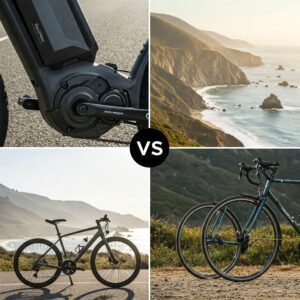
Environmental Impact: Ebike vs Bike California
California’s strong environmental focus makes sustainability considerations particularly relevant in the ebike vs bike California comparison.
Carbon Footprint
Assessing lifecycle emissions in the California context:
✅ Traditional bikes:
- Production emissions: Approximately 96kg CO₂e per bike
- Operation emissions: Zero
- Lowest overall environmental impact
✅ Ebikes:
- Production emissions: Approximately 134kg CO₂e per bike (including battery)
- Operation emissions: Minimal (estimated 1.5g CO₂e per mile based on California’s energy mix)
- Battery disposal considerations
Research from the University of California, Berkeley Transportation Sustainability Research Center indicates that each mile traveled by ebike in California instead of by car prevents approximately 300g of CO₂ emissions based on the state’s vehicle fleet composition.
Resource Utilization
California-specific resource considerations include:
✅ Traditional bikes require minimal resources beyond initial manufacturing
✅ Ebikes require ongoing electricity, ideally from renewable sources
✅ California’s high renewable energy percentage (36% of grid mix) makes ebike charging increasingly sustainable
✅ Battery components raise additional supply chain and disposal concerns
A recent Stanford University sustainability assessment concluded that both traditional bikes and ebikes represent environmentally superior alternatives to motorized transportation in California, with traditional bikes holding a slight edge in total lifecycle impact.
Practical Considerations for California Riders
Beyond performance and cost, several practical factors influence the ebike vs bike California decision for everyday riders.
Storage and Security
California’s urban centers present unique challenges:
✅ Traditional bikes:
- Easier to store in limited apartment spaces common in cities like San Francisco and Los Angeles
- Can be transported on all public transit systems without restrictions
- Lower theft target due to lower value
✅ Ebikes:
- Require more substantial storage space
- Face some restrictions on certain transit systems
- Higher theft risk necessitates enhanced security measures
- May require specialized insurance coverage
According to the California Bicycle Coalition, ebike theft has increased 27% since 2021, making security a significant consideration, particularly in urban areas.
Kryptonite New York Fahgettaboudit Chain 1410 – Essential Security for California Cyclists
When comparing ebike vs bike California security needs, the Kryptonite New York Fahgettaboudit Chain 1410 represents the gold standard in protection for both traditional and electric bicycles. This 14mm six-sided chain with a 15mm hardened steel shackle provides maximum defense against theft attempts in high-risk urban areas like San Francisco and Los Angeles, where bicycle theft rates rank among the nation’s highest.
While substantial at 10.8 pounds, this chain’s weight is a worthwhile tradeoff for the peace of mind it provides when securing valuable bicycles in California’s cities. The 3-foot length accommodates most locking scenarios, allowing riders to secure both frame and wheels to fixed objects – a necessity given that component theft is particularly common throughout the state.
Commuting Practicality
For the growing number of bicycle commuters in California:
✅ Traditional bikes:
- No range anxiety for most urban commutes
- Require changing clothes or showering facilities at workplace
- May necessitate alternate transportation on high pollution days or extreme weather
✅ Ebikes:
- Allow longer commutes without excessive exertion
- Reduce or eliminate the need for workplace shower facilities
- Enable riding on days when weather or air quality might otherwise discourage cycling
A 2023 survey by the California Department of Transportation found that ebike commuters reported an average commute distance of 9.8 miles, compared to 5.3 miles for traditional cyclists, demonstrating the extended practical range electric assistance provides.
🔌 Don’t Miss These Game-Changing E-Mobility Options! 🚲
➡ Ready to experience the freedom of electric-assisted cycling on California’s beautiful roads and trails? Click any highlighted product to check current pricing and availability on Amazon. These trusted options will help you make the most of your riding experience, whether you choose an ebike or traditional bicycle! 🌟
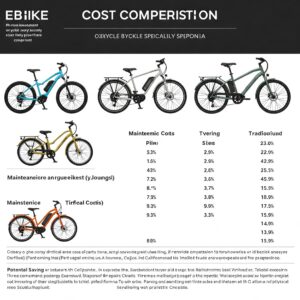
Health and Fitness: Ebike vs Bike California
The health implications of choosing between ebike vs bike California options reflect both the state’s fitness-conscious culture and practical realities.
Physical Benefits
Research specific to California cycling patterns shows:
✅ Traditional bikes:
- Provide more intense cardiovascular workout
- Engage more muscle groups at higher intensity
- Burn approximately 400-700 calories per hour depending on terrain and effort
✅ Ebikes:
- Offer moderate cardiovascular benefits
- Still engage core muscle groups
- Burn approximately 250-400 calories per hour with typical assistance levels
- Enable longer duration rides, potentially offsetting lower intensity
A landmark study published in the Journal of Transport & Health examining San Francisco Bay Area cyclists found that ebike commuters averaged 3.4 days of riding per week compared to 2.7 days for traditional cyclists, suggesting higher consistency may compensate for lower per-session intensity.
Accessibility Benefits
California’s diverse population benefits from increased cycling options:
✅ Traditional bikes require baseline fitness and may exclude:
- Older adults with decreased strength
- Individuals with certain health conditions
- Those living in extremely hilly areas
✅ Ebikes expand cycling accessibility to:
- Older riders (the fastest-growing ebike demographic in California)
- People managing health conditions or reduced fitness
- Residents of challenging topographical areas
- Those seeking to ride with more athletic partners
According to research from the University of California, Davis, ebikes have successfully introduced or reintroduced thousands of Californians to cycling who would otherwise be unable or unwilling to ride traditional bicycles.
Garmin Edge 530 GPS Cycling Computer – Essential for California Route Navigation
When navigating the diverse terrain in the ebike vs bike California comparison, the Garmin Edge 530 GPS Cycling Computer provides invaluable assistance for both traditional and electric cyclists. This advanced device offers detailed mapping capabilities essential for exploring California’s vast network of roads and trails, with preloaded maps showing cycling-specific routes throughout the state.
The Edge 530 excels in battery life, providing up to 20 hours of operation – sufficient for even the longest day rides along the Pacific Coast Highway or through wine country. Its performance monitoring features track metrics relevant to both traditional and ebike riders, while the ClimbPro feature helps prepare for California’s notorious hill challenges by providing detailed information about upcoming ascents.
Regional Considerations: Ebike vs Bike California
The ebike vs bike California decision varies significantly across the state’s diverse regions, each presenting unique circumstances and considerations.
Coastal Communities
Areas like Santa Barbara, San Diego, and Orange County present specific conditions:
✅ Traditional bikes:
- Well-suited for generally flat coastal paths
- Vulnerable to consistent ocean headwinds
- Excellent option for shorter beach town commutes
✅ Ebikes:
- Provide assistance against prevailing coastal winds
- Enable longer coastal explorations
- Offer sweat-free transportation to beach destinations
The California Coastal Commission has documented a 58% increase in cycling along designated coastal routes since 2020, with ebikes accounting for approximately 40% of this growth.
Urban Centers
Major metropolitan areas like Los Angeles and San Francisco present unique challenges:
✅ Traditional bikes:
- More maneuverable in congested urban environments
- Easier to combine with public transit
- Less worry about secure parking and charging
✅ Ebikes:
- Better suited for longer urban commutes
- Provide assistance in hilly cities like San Francisco, where some streets exceed 30% gradient
- Allow riders to arrive at destinations without requiring shower facilities
According to data from the San Francisco Municipal Transportation Agency, ebike usage has increased 83% on the city’s steepest corridors since 2021, substantially outpacing growth in flatter areas.
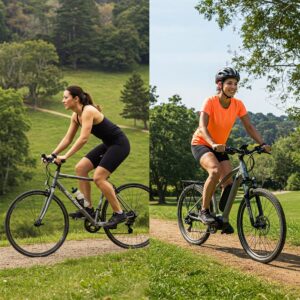
Mountain and Desert Regions
Areas like the Sierra Nevada range and inland desert communities present extreme conditions:
✅ Traditional bikes:
- Lighter weight benefits on technical mountain trails
- No battery concerns in remote areas
- Less affected by extreme temperature variations
✅ Ebikes:
- Enable exploration of challenging mountain terrain for more riders
- Allow longer rides in desert heat with reduced exertion
- Require careful planning for battery range in remote areas
The Eastern Sierra Transit Authority reports that ebike rentals have increased 112% for mountain route exploration since 2022, dramatically expanding access to scenic areas previously limited to highly conditioned cyclists.
Comparative Analysis: Ideal Use Cases
Based on comprehensive analysis of the ebike vs bike California landscape, certain scenarios clearly favor one option over the other.
When Traditional Bikes Excel in California
✅ Budget-conscious riders seeking the lowest cost of entry and ownership
✅ Fitness-focused cyclists primarily riding for exercise and training
✅ Riders primarily using well-maintained, flat bike paths in coastal communities
✅ Those with limited storage space in urban apartments
✅ Enthusiasts wanting the lightest possible option for technical trail riding
According to the California Bicycle Coalition, traditional bikes remain the preferred choice for 76% of recreational road cyclists and 68% of dedicated mountain bikers in the state.
When Ebikes Shine in California
✅ Commuters traveling more than 5 miles each way, especially in hilly areas
✅ Riders with physical limitations or reduced fitness levels
✅ Those battling consistent headwinds along coastal routes
✅ Cyclists looking to keep pace with more athletic riding partners
✅ Individuals wanting to arrive at destinations without excessive perspiration
A comprehensive survey by the California Energy Commission found that 82% of ebike owners reported riding significantly more frequently after their purchase compared to their previous traditional bike usage.
💬 Just one click – help others make better buying decisions too!😊
Ebike vs Bike California: Comparison Table
| Factor | Traditional Bikes | Ebikes | Best For |
|---|---|---|---|
| Initial Cost | $300-10,000+ | $1,000-8,000+ |
|
| Ongoing Costs | Lower maintenance | Higher maintenance + electricity |
|
| Hills & Headwinds | Requires significant effort | Assists automatically |
|
| Range | Unlimited (rider dependent) | 20-80 miles per charge |
|
| Exercise Benefit | Higher intensity | Moderate intensity, longer duration |
|
| Environmental Impact | Lowest impact | Very low impact |
|
| Regulatory Freedom | Unrestricted access | Some trail restrictions |
|
| Weight | 15-30 lbs | 45-70 lbs |
|
| Security Concerns | Lower theft risk | Higher theft target |
|
| Top Speed | Rider-dependent | 20-28 mph (class dependent) |
|
✨Was this helpful? Spread the word! 🚀
🚀 Transform Your California Riding Experience Today! 🌊
➡ Click on any recommended product to check current prices and availability. These carefully selected options are perfect for exploring California’s gorgeous coastlines, challenging mountain passes, and everything in between! 🏆
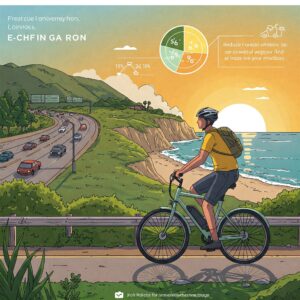
The Future of Cycling in California
The ebike vs bike California landscape continues to evolve, with several emerging trends shaping the future for riders throughout the state.
Infrastructure Development
California’s commitment to cycling infrastructure will benefit both traditional and electric cyclists:
✅ The state’s Active Transportation Program has allocated over $1.3 billion for cycling infrastructure since 2018
✅ Major cities are implementing protected bike lane networks
✅ Dedicated ebike charging stations are appearing in urban centers
✅ Bicycle highway projects like the California Coastal Trail continue to expand
According to the California Transportation Commission, these investments are projected to increase cycling trips by 38% by 2030, benefiting all types of riders.
Technological Advancements
Innovation continues to shape the ebike vs bike California comparison:
✅ Traditional bikes are becoming lighter and more efficient with advanced materials
✅ Ebike batteries are increasing in range while decreasing in weight and charge time
✅ Smart features like GPS tracking and integrated security are becoming standard
✅ Solar charging options are emerging for sustainable recharging
Industry analysis by the California Clean Technology Fund projects that average ebike range will increase 30% by 2027 while weight decreases by 15%, further blurring the lines between traditional and electric options.
Policy Evolution
California’s regulatory environment continues to develop:
✅ Expanding incentive programs for ebike purchases, particularly for low-income residents
✅ Standardizing regulations across municipalities for greater consistency
✅ Addressing ebike access to additional trail systems and natural areas
✅ Developing comprehensive end-of-life recycling programs for batteries
The California Bicycle Advisory Committee anticipates these policy developments will further accelerate adoption of both traditional and electric bicycles throughout the state.
Conclusion: Making Your Ebike vs Bike California Decision
The ebike vs bike California comparison ultimately comes down to personal circumstances, preferences, and intended use. For many Californians, the ideal solution might include both options – a traditional bike for fitness-focused recreational rides and an ebike for practical transportation and extended adventures.
As I’ve discovered through years of cycling throughout this beautiful state, both traditional bikes and ebikes offer tremendous benefits. Traditional bikes continue to excel in simplicity, affordability, and pure cycling experience, while ebikes open new possibilities for distance, accessibility, and practical transportation.
Consider your typical riding environment, fitness goals, budget, and storage situation when making your choice. Test ride both options whenever possible, particularly on terrain similar to where you’ll be riding most frequently. Remember that California’s diverse landscape might call for different solutions depending on your location and riding ambitions.
Whatever you choose in the ebike vs bike California debate, you’ll be joining a growing community of cyclists enjoying one of the most beautiful and bike-friendly states in the nation. The important thing is to ride safely, respectfully, and joyfully as you explore all that California has to offer on two wheels.
🔋 Elevate Your California Cycling Experience! 🌞
➡ Don’t miss the chance to transform your riding experience with these top-rated products. Whether you’re exploring coastal highways or urban bike lanes, these items will enhance your safety, comfort, and enjoyment. Click any highlighted product to see current pricing and availability! 🔥

More FAQs
❓ What are the legal differences between ebikes and regular bikes in California?
✅ Regular bikes have unrestricted access to roads and trails, while ebikes are classified into three categories with specific regulations. Class 1 and 2 (20mph max) can use most bike paths, while Class 3 (28mph max) has more restrictions. Some wilderness areas prohibit all electric assistance...
❓ How much can I save with California's ebike incentive programs?
✅ California offers rebates up to $750 for qualifying ebike purchases, with additional incentives available in certain air districts. Low-income residents can receive up to $1,500 in some regions. These programs can reduce the cost gap between traditional and electric options by 20-40%...
❓ Are ebikes worth the extra cost for commuting in California cities?
✅ For commutes over 5 miles or in hilly areas like San Francisco, ebikes typically justify their higher cost within 1-2 years through reduced public transit expenses and time savings. Urban commuters report 45% higher consistency in bike commuting after switching to ebikes...
❓ What's the best bike type for California's coastal roads?
✅ For coastal riding, ebikes excel against consistent ocean headwinds while traditional road bikes offer better performance on calm days. Hybrids and gravel bikes provide versatility for mixed coastal terrain. Consider typical wind conditions and ride length when choosing which option better suits your coastal adventures...
❓ How do California's extreme temperatures affect ebike performance?
✅ In hot desert regions (100°F+), ebike batteries typically experience 15-20% reduced range and accelerated degradation without proper care. Cold coastal mornings below 50°F can temporarily reduce range by 10-15%. Quality ebikes include thermal management systems to minimize these effects...
Recommended for You:
- 7 Best American E Bikes That Will Revolutionize Urban Commuting in 2025
- American Made E Bikes: The Ultimate 2025 Guide to Effortlessly Power Up Your Ride
- Ebike Black Friday 2025: 15 Mind-Blowing Deals You Can’t Afford to Miss
Disclaimer: This article contains affiliate links. If you purchase products through these links, we may earn a small commission at no additional cost to you.
✨ Found this helpful? Share it with your friends! 💬🤗

